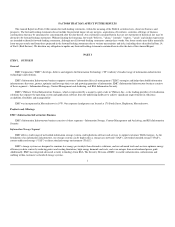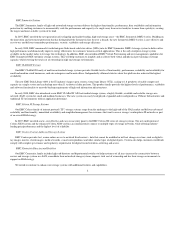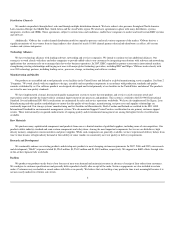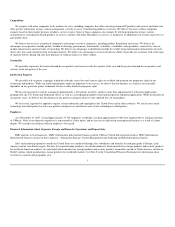EMC 2007 Annual Report Download - page 14
Download and view the complete annual report
Please find page 14 of the 2007 EMC annual report below. You can navigate through the pages in the report by either clicking on the pages listed below, or by using the keyword search tool below to find specific information within the annual report.
the timing of recognizing revenue in any given quarter as a result of software revenue recognition policies;
the sale of VMware products in the timeframes they anticipate, including the number and size of orders in each quarter;
VMware's ability to develop, introduce and ship in a timely manner new products and product enhancements that meet customer demand,
certification requirements and technical requirements;
the amount of equity-based compensation expense as a result of VMware equity grants;
VMware's ability to effectively manage future growth and acquisitions;
changes to VMware's effective tax rate;
the increasing scale of VMware's business and its effect on VMware's ability to maintain historical rates of growth;
the timing of the announcement or release of products or upgrades by VMware or by its competitors;
VMware's ability to implement scalable systems of internal controls;
VMware's ability to control costs, including its operating expenses;
VMware's ability to attract and retain highly skilled employees, particularly those with relevant experience in software development and sales;
and
general economic conditions in VMware's domestic and international markets.
Our stock price is volatile and may be affected by the trading price of VMware Class A common stock and/or speculation about the possibility of
future actions we might take in connection with our VMware stock ownership.
Our stock price, like that of other technology companies, is subject to significant volatility because of factors such as:
the announcement of acquisitions, new products, services or technological innovations by us or our competitors;
quarterly variations in our operating results;
changes in revenue or earnings estimates by the investment community; and
speculation in the press or investment community.
The trading price of our common stock has been and likely will continue to be affected by various factors related to VMware, including:
the trading price for VMware Class A common stock;
actions taken or statements made by us, VMware, or others concerning the potential separation of VMware from us, including by spin-off, split-
off or sale; and
factors impacting the financial performance of VMware, including those discussed in the prior risk factor.
In addition, although we own a majority of VMware and consolidate their results, our stock price may not reflect our pro rata ownership interest of
VMware.
If our suppliers are not able to meet our requirements, we could have decreased revenues and earnings.
We purchase or license many sophisticated components and products from one or a limited number of qualified suppliers, including some of our
competitors. These components and products include disk drives, high density memory components, power supplies and software developed and maintained
by third parties. We have experienced delivery delays from time to time because of high industry demand or the inability of some vendors to consistently meet
our quality or delivery requirements. If any of our suppliers were to cancel or materially change contracts or commitments with us or fail to meet the quality
or delivery requirements needed to satisfy customer orders for our products, we could lose time-sensitive customer orders, be unable to develop or sell certain
products cost-effectively or on a timely basis, if at all, and have significantly decreased quarterly revenues and earnings, which would have a material adverse
effect on our business, results of operations and financial condition. Additionally, we periodically transition our product line to incorporate new technologies.
The importance of transitioning our customers smoothly to new technologies, along with our historically uneven pattern of quarterly sales, intensifies the risk
that the failure of a supplier to meet our quality or delivery requirements will have a material adverse impact on our revenues and earnings.
Our business could be materially adversely affected as a result of the risks associated with acquisitions and investments.
As part of our business strategy, we seek to acquire businesses that offer complementary products, services or technologies. These acquisitions are
accompanied by the risks commonly encountered in an acquisition of a business, which may include, among other things:
the effect of the acquisition on our financial and strategic position and reputation;
the failure of an acquired business to further our strategies;
the failure of the acquisition to result in expected benefits, which may include benefits relating to enhanced revenues, technology, human
resources, cost savings, operating efficiencies and other synergies;
10
•
•
•
•
•
•
•
•
•
•
•
•
•
•
•
•
•
•
•
•
•
•
























